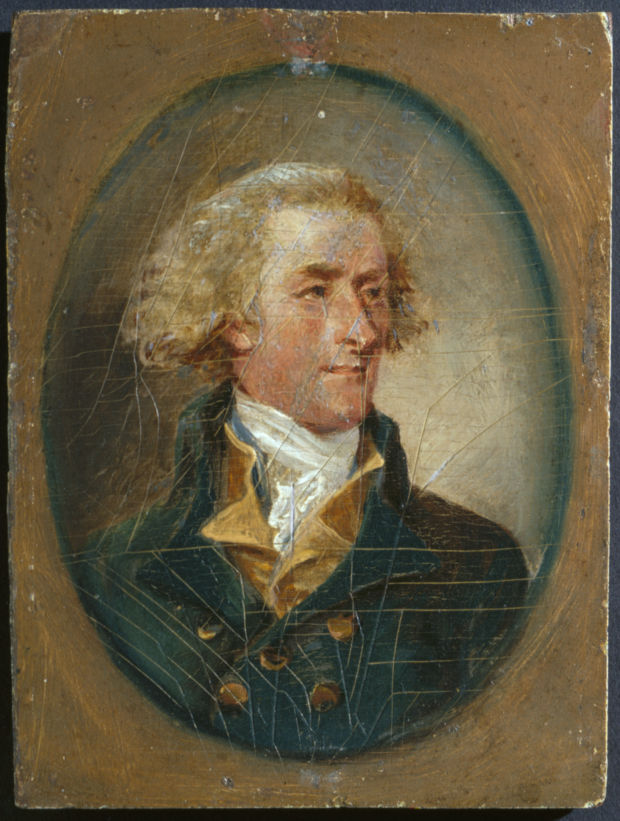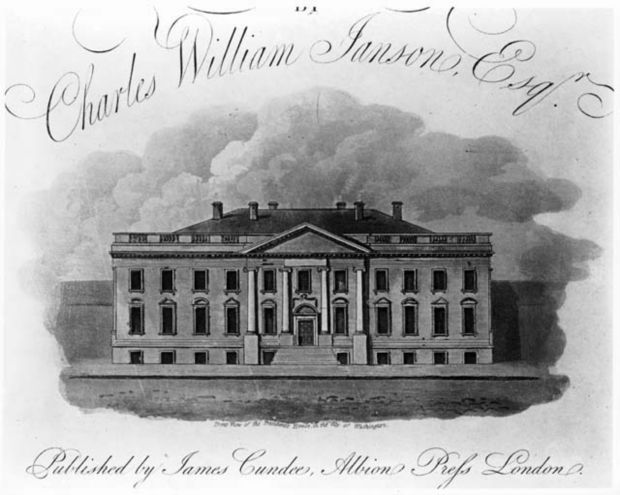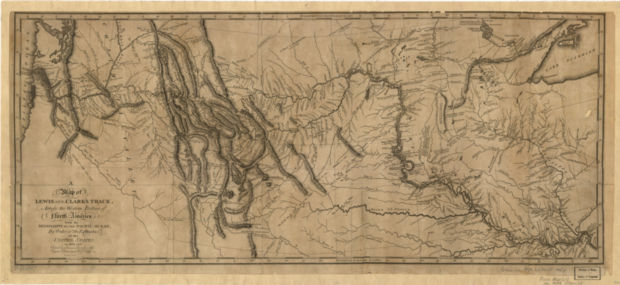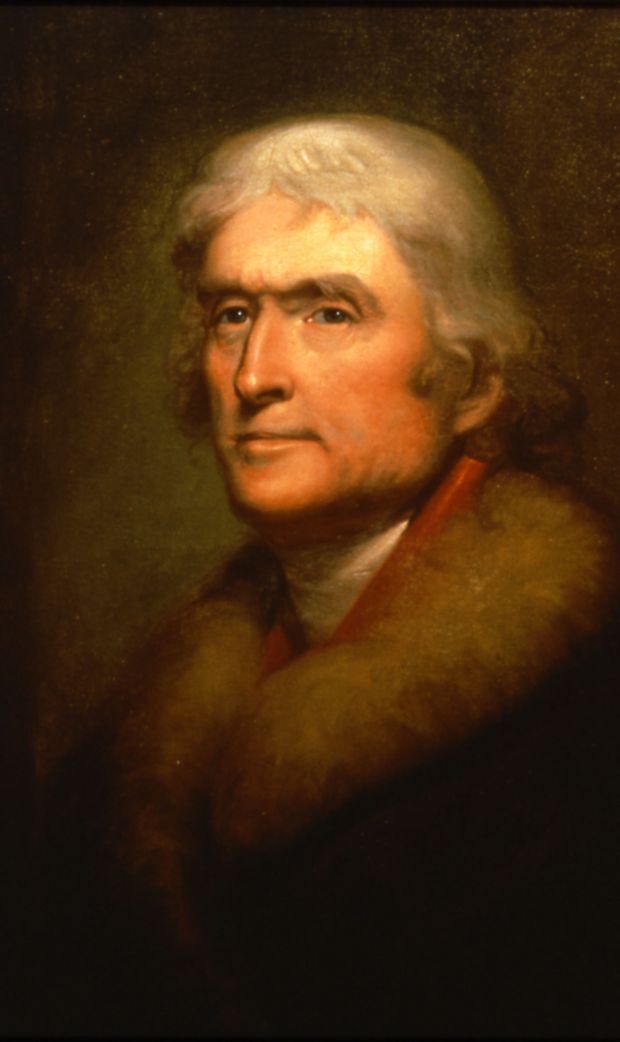Thomas Jefferson: President of the United States
Reading Level: Elementary School

This 1788 portrait of Jefferson by John Trumbull shows Jefferson at age 33.
Election of 1800
In 1800, Thomas Jefferson ran for president of the United States. John Adams also wanted to be president. Jefferson and Aaron Burr ran as Republicans. John Adams and Charles Pinkney ran as Federalists. There were many differences between the two groups.
Republicans felt that the government belonged to all the people. They believed most people could make good decisions about their country. They wanted strong state and local governments. Thomas Jefferson and James Madison were Republicans.
Federalists felt that only educated men could make decisions. They wanted a strong federal (central) government. George Washington, Alexander Hamilton and John Adams were Federalists.
Federalists said that “a vote for Jefferson was a vote against God.” The Republicans said that Adams wanted to rule like a king. New England and much of the north supported the Federalists. Virginia and much of the south supported the Republicans. Many feared that the differences between the groups could lead to a civil war.

Before 1812 the White House was known as the President’s House.
Thomas Jefferson and Aaron Burr beat John Adams and Charles Pinkney. But Jefferson and Burr each had 73 votes. They had tied for the presidency! Today there are separate elections for vice-president. During Jefferson’s time, there were not separate elections. The House of Representatives had to break the tie. They would decide who would be president and who would be vice-president.
In February 1801, representatives from the House voted. Over a hundred people waited in the streets of Washington D.C. to see who won. The voting dragged on. Finally, Alexander Hamilton, a Federalist, helped decide the vote. He said that Jefferson was the safer choice. The representatives voted again. Thomas Jefferson won by one vote. He became the third president of the United States.
Three years later, Congress passed the Twelfth amendment. It made separate voting for president and vice-president.
“We are all Republicans: we are all federalists.
Jefferson called the election of 1800 the “bloodless revolution.” There had been no civil war. Power from one group (the Federalists) had been peacefully handed to another group (the Republicans). Jefferson believed the election united the people in the “strongest Government on earth.” Others thought the differences between the Federalists and the Republicans would cause problems. It was up to Jefferson to create peace between the two groups.
On March 4th Jefferson was inaugurated as president. That day he stayed true to his beliefs. He walked from his house to the Capitol. Most presidents had ridden in fancy carriages. He wore plain clothes. Most presidents had worn fancy clothes. He told everyone, “Let us, then, fellow citizens, unite with one heart and one mind. . . . We are all republicans: we are all federalists.” All over the nation, bells rang and guns fired in celebration. People cheered for the new president.

This map shows the boundaries of the Louisiana Purchase as recognized today. In 1802, the U.S. and its territories occupied most of the land to east.
Louisiana Purchase
When Jefferson was president, he worked to buy the Louisiana Territory. Since the American Revolution, settlers had crossed the Appalachian Mountains. They settled in the “west.” This land was owned by Spain. Spain said that settlers could use the Mississippi River. They could use the port of New Orleans to ship their goods to market. But then Spain gave France the rights to their land in the “west”.
Jefferson wanted the land for the United States. He wanted America to stretch from the Atlantic Ocean to the Pacific Ocean. He sent James Monroe to France to join Robert Livingston. Their goal was to buy New Orleans and part of Florida. Congress had approved ten million dollars to spend.
Napoleon was ruler of France. He was getting ready to go to war with England. France needed money for the war. The country did not have the armies to defend the land in America. Napoleon offered the land to the United States. It was called the Louisiana Territory.
At the time, the Louisiana Territory was mysterious. Few men had explored it. No white man had ever been all the way up the Missouri River. Some people believed there was a huge ocean in the middle of the territory. Others believed it was filled with strange animals. Most hoped there was a river that went all the way to the Pacific Ocean.
On April 30th 1803, Monroe and Livingston bought the Louisiana Territory. They paid France $15 million dollars. (That was about three cents per acre). The land stretched north to where the Missouri River began as a tiny stream. It stretched west to the Rocky Mountains. The Mississippi River and the Port of New Orleans were now part of the United States. Jefferson and most of the American people were excited!

This map of the western part of the Lewis and Clark Expedition was drawn by Samuel Lewis (no relation to Meriwether) using drawings supplied by William Clark.
Lewis and Clark
Jefferson had always planned to explore the Louisiana Territory. He got his secretary, Meriwether Lewis, ready for the adventure. Lewis had been a U.S. army captain in the “west”. He had met Native Americans and learned some of their words.
Jefferson wanted the explorers to travel across the new territory. He wanted them to find a river to the Pacific Ocean. He wanted them to trade with the Native Americans. He wanted the Indians to understand the power of “The Great White Father in Washington.” He asked Lewis to write about “the animals of the country generally, and especially those not known in the United States.”
On May 1804, Captain Lewis, Captain William Clark and about forty other explorers headed up the Missouri River. They were later joined by their Shoshone guide Sacagawea and her husband Toussaint Charbonneau. They traveled across dry prairies. They climbed snow-covered mountains. They traveled over three thousand miles. They were gone two years, four months and nine days.
On the trip, they lived off the land, built shelters and shot game. They traded with the Native Americans. They traded glass beads, tobacco and knives for food and horses. They named rivers and streams after famous Americans. Finally, they found the Columbia River. From there they traveled to the Pacific Ocean.
Jefferson thought the trip would only take a year. He thought the explorers were lost. Finally, the explorers returned to St. Louis in September 1806. Jefferson felt “unspeakable joy” in their safe arrival.
Lewis had much to report to Jefferson. He said there was no river to the Pacific Ocean. He reported that the Native American tribes such as the Shoshone and Nez Perce were not interested in being ruled by “The Great White Father in Washington.”
Lewis also told about the many wonderful things the explorers had discovered. They wrote about prairie wolves (coyotes) and barking squirrels (prairie dogs). They drew over a dozen maps. They sent back samples of the Osage orange and yucca. They wrote of attacks by Blackfeet Indians and grizzly bears. People everywhere read the stories of the amazing trip to the “wild west.”

This drawing from 1897 by Fred S. Cozzens depicts the attack on the U.S.S. Chesapeake by the British ship H.M.S. Leopard in June 1807.
Embargo Acts
Jefferson’s second term of office was not as successful as his first. War had broken out between France and Great Britain. Both countries needed supplies from American. The United States was neutral. They traded with both countries. The supplies were sent oversea by ships. France did not want America to trade with Great Britain. Great Britain tried to stop America from trading with France. Both countries attacked US ships.

Copy of an 1805 portrait of Thomas Jefferson by Rembrandt Peale; copy by James L. Dick.
Hoping to stop the attacks, the US passed the Embargo Acts. Embargo is an order from the government. It says that ships can not leave or enter a port. The Embargo Acts were laws passed by Congress. Jefferson supported the Acts. He hoped they would keep America out of the war between France and Great Britain.
Congress passed the first act in Dec. 1807. It closed all American ports. Supplies could not be shipped to other countries (exports). Farmers and merchants did not like the embargo. They could not export their goods. Many ignored the laws. They smuggled their goods through Canada. Jefferson made even tougher laws. The laws said the U.S. Army and Navy could enforce (carry out) the embargo. This made people even madder.
Finally the Embargo Acts were repealed. Trade was allowed with all countries except France and Great Britain. But the embargo had turned the people against Jefferson. The Acts also didn’t keep America neutral. In 1812, the United States went to war with Great Britain.
Jefferson did not want to be president for another term. He did not want the president of the United States to like a king, who could be in power forever. (In 1951, the US Constitution limited a president’s time in office to two terms.) In the end, Jefferson was true to his Republican beliefs.

